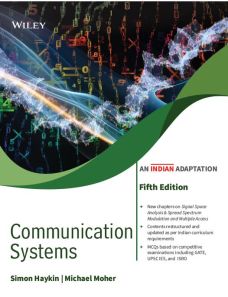Communication Systems, 5ed, An Indian Adaptation
ISBN: 9789354640896
608 pages
Publication Year: 2022
For more information write to us at: acadmktg@wiley.com

Description
This best-selling Communication Systems textbook continues to include the most comprehensive and rigorous coverage of both analog and digital communications. In addition to being the most up-to-date communications text available, the book lays an emphasis on the statistical underpinnings of communication theory with applications. The book presents material in a logical manner, and is illustrated with numerous examples, with the overall aim being that of helping the student develop an intuitive grasp of the theory under discussion.
Chapter 1 Prologue
1.1 The Communication Process
1.2 Analog and Digital Types of Communication
1.3 Modulation Process
1.4 The Layered Approach
1.5 Shannon’s Information Capacity Theorem
1.6 A Digital Communication Problem
1.7 Theme Example—Wireless Communications
Chapter 2 Fourier Representation of Communication Signals and Systems
2.1 Introduction
2.2 Introduction to Fourier Series and Discrete Spectrum
2.3 The Fourier Transform and Continuous Spectrum
2.4 Properties of the Fourier Transform
2.5 The Inverse Relationship Between Time and Frequency
2.6 Dirac Delta Function
2.7 Fourier Transforms of Periodic Signals
2.8 Transmission of Signals Through Linear Systems
2.9 Filters
2.10 Low-Pass and Band-Pass Signals
2.11 Band-Pass Systems
2.12 Phase and Group Delay
2.13 Sources of Information
2.14 Numerical Computation of the Fourier Transform
2.15 Theme Example–Channel Estimation of a Wireless LAN Channel
2.16 Summary and Discussion
Chapter 3 Amplitude Modulation
3.1 Introduction
3.2 Amplitude Modulation
3.3 Double Sideband–Suppressed Carrier Modulation
3.4 Quadrature-Carrier Multiplexing
3.5 Single Sideband and Vestigial Sideband Methods of Modulation
3.6 Theme Example—VSB Transmission of Analog and Digital Television
3.7 Frequency Translation
3.8 Frequency-Division Multiplexing
3.9 The Superheterodyne Receiver
3.10 Practical AM Communication Systems
3.11 AM Broadcasting and Broadcasting Standards for India
3.12 Summary and Discussion
Chapter 4 Phase and Frequency Modulation
4.1 Introduction
4.2 Basic Definitions
4.3 Frequency Modulation
4.4 Generation of FM Signals
4.5 Demodulation of FM Signals
4.6 Phase-Locked Loop
4.7 Nonlinear Effects in FM Systems
4.8 Practical FM Communication Systems
4.9 FM Broadcasting and Broadcasting Standards for India
4.10 Theme Example—Analog and Digital FM Cellular Telephones
4.11 Summary and Discussion
Chapter 5 Random Variables and Processes
5.1 Introduction
5.2 Probability
5.3 Random Variables
5.4 Statistical Averages
5.5 Random Processes
5.6 Stationary Random Processes
5.7 Mean, Correlation, and Covariance Functions
5.8 Ergodic Processes
5.9 Transmission of a Random Process Through a Linear Filter
5.10 Power Spectral Density
5.11 Gaussian Process
5.12 Theme Example—Stochastic Model of a Mobile Radio Channel
5.13 Summary and Discussion
Chapter 6 Noise in Communication Systems
6.1 Introduction
6.2 Noise
6.3 Narrow-Band Noise
6.4 Receiver Model
6.5 Noise in DSB–SC Receivers
6.6 Noise in AM Receivers
6.7 Noise in FM Receivers
6.8 Pre-emphasis and De-emphasis in FM
6.9 Theme Example—Link Budget of FM Satellite Link
6.10 Summary and Discussion
Chapter 7 Digital Representation of Analog Signals
7.1 Introduction
7.2 Why Digitize Analog Sources?
7.3 The Sampling Process
7.4 Pulse Modulation Techniques
7.5 Bandwidth–Noise Trade-Off
7.6 Time-Division Multiplexing
7.7 Theme Example—PPM in Impulse Radio
7.8 The Quantization Process
7.9 Pulse-Code Modulation
7.10 Delta Modulation
7.11 Linear Prediction
7.12 Differential Pulse-Code Modulation
7.13 Adaptive Differential Pulse-Code Modulation
7.14 MPEG Audio Coding Standard
7.15 Theme Example—Digitization of Video and MPEG
7.16 Summary and Discussion
Chapter 8 Signal-Space Analysis
8.1 Introduction
8.2 Geometric Representation of Signals
8.3 Conversion of the Continuous AWGN Channel into a Vector Channel
8.4 Likelihood Functions
8.5 Coherent Detection of Signals in Noise: Maximum Likelihood Decoding
8.6 Correlation Receiver
8.7 Probability of Error
8.8 Summary and Discussion
Chapter 9 Baseband Transmission of Digital Signals
9.1 Introduction
9.2 Baseband Pulses and Matched Filter Detection
9.3 Probability of Error Due to Noise
9.4 Intersymbol Interference
9.5 Eye Pattern
9.6 Nyquist’s Criterion for Distortionless Transmission
9.7 Correlative-Level Coding
9.8 Baseband M-ary PAM Transmission
9.9 Tapped-Delay-Line Equalization
9.10 Theme Example—100BASE-TX— Transmission of 100 Mbps Over Twisted Pair
9.11 Summary and Discussion
Chapter 10 Band-Pass Transmission of Digital Signals
10.1 Introduction
10.2 Band-Pass Transmission Model
10.3 Transmission of Binary PSK and FSK
10.4 M-ary Data Transmission Systems
10.5 Comparison of Noise Performances of Various PSK and FSK Systems
10.6 Theme Example—Orthogonal Frequency Division Multiplexing (OFDM)
10.7 Summary and Discussion
Chapter 11 Spread Spectrum and Multiple Access
11.1 Introduction
11.2 Pseudo-Noise Sequences
11.3 A Notion of Spread Spectrum
11.4 Direct-Sequence Spread Spectrum with Coherent Binary Phase-Shift Keying
11.5 Signal-Space Dimensionality and Processing Gain
11.6 Probability of Error
11.7 Frequency-Hop Spread Spectrum
11.8 Multiple Access
11.9 Summary and Discussion
Chapter 12 Information and Forward Error Correction
12.1 Introduction
12.2 Uncertainty, Information, and Entropy
12.3 Source-Coding Theorem
12.4 Lossless Data Compression
12.5 Theme Example—The Lempel–Ziv Algorithm and File Compression
12.6 Discrete Memoryless Channels
12.7 Mutual Information
12.8 Channel Capacity
12.9 Channel Coding Theorem
12.10 Capacity of a Gaussian Channel
12.11 Error Control Coding
12.12 Linear Block Codes
12.13 Cyclic Codes
12.14 Convolutional Codes
12.15 Maximum Likelihood Decoding of Convolutional Codes
12.16 Trellis-Coded Modulation
12.17 Turbo Codes
12.18 Summary and Discussion
Notes and References
Problems
Multiple Choice Questions
Appendix Mathematical Tables
Glossary
Bibliography
Index

